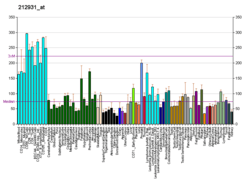TCF20
Transcription factor 20 is a protein that in humans is encoded by the TCF20 gene.[5][6][7]
The protein encoded by this gene binds a platelet-derived growth factor-responsive element in the matrix metalloproteinase 3 (stromelysin 1) promoter. The protein localizes to the nucleus and displays DNA-binding and transactivation activities. It is thought to be a transcriptional coactivator, enhancing the activity of transcription factors such as JUN and SP1. Alternative splicing results in two transcript variants encoding different isoforms.[7]
Interactions
References
- 1 2 3 ENSG00000281897, ENSG00000262024, ENSG00000282892, ENSG00000283026, ENSG00000280467, ENSG00000100207, ENSG00000276461 GRCh38: Ensembl release 89: ENSG00000283681, ENSG00000281897, ENSG00000262024, ENSG00000282892, ENSG00000283026, ENSG00000280467, ENSG00000100207, ENSG00000276461 - Ensembl, May 2017
- 1 2 3 GRCm38: Ensembl release 89: ENSMUSG00000041852 - Ensembl, May 2017
- ↑ "Human PubMed Reference:".
- ↑ "Mouse PubMed Reference:".
- ↑ Rajadhyaksha A, Riviere M, Van Vooren P, Szpirer J, Szpirer C, Babin J, Bina M (October 1998). "Assignment of AR1, transcription factor 20 (TCF20), to human chromosome 22q13.3 with somatic cell hybrids and in situ hybridization". Cytogenet Cell Genet. 81 (3–4): 176–7. doi:10.1159/000015021. PMID 9730594.
- ↑ Rekdal C, Sjottem E, Johansen T (January 2001). "The nuclear factor SPBP contains different functional domains and stimulates the activity of various transcriptional activators". J Biol Chem. 275 (51): 40288–300. doi:10.1074/jbc.M006978200. PMID 10995766.
- 1 2 "Entrez Gene: TCF20 transcription factor 20 (AR1)".
- ↑ Lyngsø, C; Bouteiller G; Damgaard C K; Ryom D; Sanchez-Muñoz S; Nørby P L; Bonven B J; Jørgensen P (August 2000). "Interaction between the transcription factor SPBP and the positive cofactor RNF4. An interplay between protein binding zinc fingers". J. Biol. Chem. UNITED STATES. 275 (34): 26144–9. doi:10.1074/jbc.M003405200. ISSN 0021-9258. PMID 10849425.
Further reading
- Sanz L, Moscat J, Diaz-Meco MT (1995). "Molecular characterization of a novel transcription factor that controls stromelysin expression". Mol. Cell. Biol. 15 (6): 3164–70. PMC 230548. PMID 7760812.
- Kirstein M, Sanz L, Quiñones S, et al. (1996). "Cross-talk between different enhancer elements during mitogenic induction of the human stromelysin-1 gene". J. Biol. Chem. 271 (30): 18231–6. doi:10.1074/jbc.271.30.18231. PMID 8663478.
- Ohara O, Nagase T, Ishikawa K, et al. (1997). "Construction and characterization of human brain cDNA libraries suitable for analysis of cDNA clones encoding relatively large proteins". DNA Res. 4 (1): 53–9. doi:10.1093/dnares/4.1.53. PMID 9179496.
- Dunham I, Shimizu N, Roe BA, et al. (1999). "The DNA sequence of human chromosome 22". Nature. 402 (6761): 489–95. Bibcode:1999Natur.402..489D. doi:10.1038/990031. PMID 10591208.
- Lyngsø C, Bouteiller G, Damgaard CK, et al. (2000). "Interaction between the transcription factor SPBP and the positive cofactor RNF4. An interplay between protein binding zinc fingers". J. Biol. Chem. 275 (34): 26144–9. doi:10.1074/jbc.M003405200. PMID 10849425.
- Strausberg RL, Feingold EA, Grouse LH, et al. (2003). "Generation and initial analysis of more than 15,000 full-length human and mouse cDNA sequences". Proc. Natl. Acad. Sci. U.S.A. 99 (26): 16899–903. Bibcode:2002PNAS...9916899M. doi:10.1073/pnas.242603899. PMC 139241. PMID 12477932.
- Beausoleil SA, Jedrychowski M, Schwartz D, et al. (2004). "Large-scale characterization of HeLa cell nuclear phosphoproteins". Proc. Natl. Acad. Sci. U.S.A. 101 (33): 12130–5. Bibcode:2004PNAS..10112130B. doi:10.1073/pnas.0404720101. PMC 514446. PMID 15302935.
- Rush J, Moritz A, Lee KA, et al. (2005). "Immunoaffinity profiling of tyrosine phosphorylation in cancer cells". Nat. Biotechnol. 23 (1): 94–101. doi:10.1038/nbt1046. PMID 15592455.
- Gburcik V, Bot N, Maggiolini M, Picard D (2005). "SPBP is a phosphoserine-specific repressor of estrogen receptor alpha". Mol. Cell. Biol. 25 (9): 3421–30. doi:10.1128/MCB.25.9.3421-3430.2005. PMC 1084313. PMID 15831449.
- Olsen JV, Blagoev B, Gnad F, et al. (2006). "Global, in vivo, and site-specific phosphorylation dynamics in signaling networks". Cell. 127 (3): 635–48. doi:10.1016/j.cell.2006.09.026. PMID 17081983.
- Sjøttem E, Rekdal C, Svineng G, et al. (2007). "The ePHD protein SPBP interacts with TopBP1 and together they co-operate to stimulate Ets1-mediated transcription". Nucleic Acids Res. 35 (19): 6648–62. doi:10.1093/nar/gkm739. PMC 2095823. PMID 17913746.
This article is issued from
Wikipedia.
The text is licensed under Creative Commons - Attribution - Sharealike.
Additional terms may apply for the media files.




